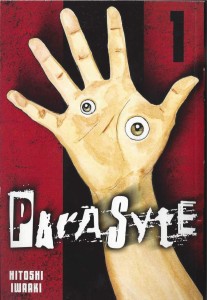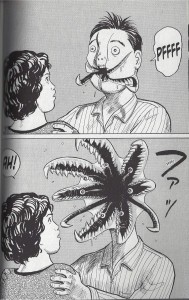“Keeping It Ghastly” is a bi weekly article on Japanese horror comics which have English print editions. Some are from famous authors, others are from unknowns and underground artist circles. Either way, it’s going to be to a terrifying/awesome ride to keep horror manga on our bookshelves!

It does my little shriveled heart good to see a horror manga that has continued to thrive. Despite the many times that this story has switched publishers, and in spite of the difficulty of laying your hands on the complete run of any one edition, Hitoshi Iwaaki’s science fiction horror series Parasyte continues to grace the bookshelves of new and used stores here in the U.S. of A. The staying power of Parasyte has even resulted in a new anime series released between 2014 and 2015.
Falling to Earth in tennis ball sized spores, little flatworms with vicious looking drills for heads sprout and begin looking for a host body to seize control of. In the same way that the creature from The Thing imitates the flesh and behavior of the host, so too do these sentient worms harness their hosts’ bodies in order to blend into the herd undetected. If threatened they can do some pretty horrendous Cronenberg-y transformations. I’ll let this picture speak for itself.

The complexity of the story in Parasyte is evident in the first volume alone. And for a media that is infamous for slow burn stories and passive-aggressive horror this is saying something. The rogues gallery is not simply comprised of “flavor of the week” villains like many shonen titles. Even tertiary characters like our protagonist, Shinichi’s, peripheral classmates get character arcs that drive individual chapters toward the greater story of human kind’s first alien contact. Inevitable change and evolution are central to the horror aspects of Parasyte, and we see these themes played out in many areas from the lonely path Shinichi must tread as the host of a “failed” parasite (a worm that was not able to gain full control of the host or didn’t enter a member of the planet’s dominant species). From the eldritch changes his body goes through, to the cultural shifts that occur once the world becomes more and more aware of the predator in their midst, Parasyte strives and succeeds to tell a multifaceted, immersive story.

First there was Mixx, which later rebranded itself as the famous Tokyopop label. Both company names put out editions of Parasyte in the old right-to-left format with significantly different translations of the original Japanese text. Then Del Rey put out their own translation of Parasyte, and finally out came Kodansha Comics USA’s current edition. The Kodansha Comics edition is particularly fun as it not only includes the standard translations of Japanese honorifics, foods, and phrases, but little notes regrading the publishing history of the title! For instance, the editor took the time to point out that the series used to be published as a serial in Japan, hence the short recaps before each chapter. For fans who may be wondering why Migi, which means “right”, used to be called Lefty in the earlier editions, the editor notes that the manga was previously published with “flipped art” that necessitated the renaming. Is this a truly necessary thing to dedicate precious page space to? Not really, but it certainly adds to the mystique that this is a book with a decent history in the English language.
Save






Comments are closed.